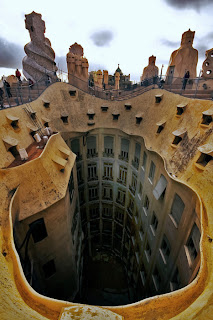Executive summary by darmansjah
Let's feel the genius of Gaudi architecture through the design of surprises. Banging on all the artistic senses. Overturning stability, by Myrna Ratna
Sagrada Familia
From across the street Passeig de Gracia, buildings numbered 92 are located right on the corner of the bend is reminiscent of something. Have we seen the shadow of a building on the water surface? Moving, curved, and may be asymmetrical?
Mila's house or Casa Mila, known as La Pedrera (stone quarry) has that characteristic. There's hardly a straight line in this building. Strictly speaking, no normal silhouette similar to the surrounding construction. From a distance, Casa Mila is like a cloud-swept hill.
Antoni Gaudi i Cornet (1852-1926), the architect, is a perfect representation of the expressive character of the Catalan, always turbulent, and feel at odds with the mainstream. His work is an interpretation of modernism that was sweeping Europe at that time. A period in which Picasso, Joan Miro, and Domenech Montaner also found its momentum, and the coincidence in the same city, Barcelona. Coincidence? Maybe not. Barcelona was so biased that allow their ideas unusual was accepted, appreciated, and eventually became a cultural heritage.
The works of Gaudi was initially questioned. When the Casa Mila was standing in the middle row of buildings that have the graceful neoclassical architecture, you can imagine the shock it caused. However, Gaudi's vision is already beyond his time. Nearly a century later, when we are currently keen to talk about returning to nature, Gaudi had it happen in all his works are scattered in Barcelona and other cities in Spain, such as Casa Vicens, Casa Calvet, Casa Batlo, or ..
Nature is the main inspiration Gaudi. Observations of natural phenomena and objects in it-branches that propagate, dried fruit and pine are scattered on the ground, sunflowers are blooming, and the probe leaves the sun-he moved into the design.
On the roof of Casa Mila, we will drown in it genius. Immersed in the wilderness wanderings. Walking among the twisted chimney like ice cream that was melting. Stared at the row of towers that resemble masked troops. Entering the dome with holes in the roof, not unlike a sprinkling of stars.
However, culminating in his masterpiece Sagrada Familia, which now seemed to be the spirit of Barcelona. Difficult to describe in words the beauty that will be encountered in the basilica, which was never completed it (like it is planned as such by Gaudi), unless we enter and try to understand it.
Pine
Climb the narrow stairs that curved like a spiral, and while occasionally peering towards the window of the small stones that lined the side of the stairs dragging directly on the path of imagination. From the point of that little window visible church towers are flanked by peaks of different shapes.
There is a similar fruit prickly pine, there is a round arched with balls that surround it, like a fungus that is broke. In another peak, shaped like pine trees that were seized with the pigeons. From the corner of the windows of the narrow stone, Gaudi offers painting with the background stretch of the city of Barcelona.
In the main room Sagrada Familia, we like being in a forest. The pillars support each other like the trunks of giant trees towering toward the sun. The flowers bloomed in the ceiling that bias affected stained glass. The main dome was supported enumerated by massive pillars resembling the trunks of bamboo trees.
Gaudi spent more than 40 years (1883-1926) to build this church, and the last 12 years he dedicated entirely to this project until his death. This church remains the building was never completed. Like the spirit that continues to envelop the city he loves, Barcelona.













No comments:
Post a Comment